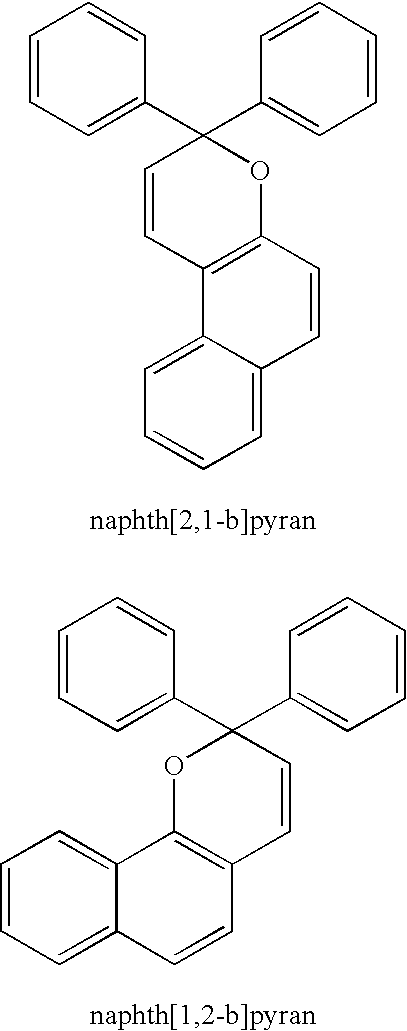Photochromic plate containing melanin
a technology of melanin and photochromic plate, which is applied in the field of transparent plate, can solve the problems of high light transmission suitable for indoor use, particularly toxic to the aging retina, and inability to meet the needs of outdoor us
- Summary
- Abstract
- Description
- Claims
- Application Information
AI Technical Summary
Benefits of technology
Problems solved by technology
Method used
Image
Examples
example 1
[0057] A thermoplastic polyurethane CLC93A obtained from Thermedics Polymer Products (Boston, Mass.) was dissolved in tetrahydrofuran to make a solution containing 25% polyurethane. To the solution was added 0.3%, by weight, of a hydrophobic melanin obtained from Photoprotective Technologies (San Antonio, Tex.), and 2.0% of a gray coloring photochromic dye. The mixture was vigorously stirred for few hours to ensure dissolving of the melanin pigment and the photochromic dye.
[0058] The resulting solution was cast on a T50 release liner obtained from CPFilms (Martinsville, Va.). The cast film was dried on a 60° C. hot surface for 5 minutes to yield a 0.075 mm thick photochromic polyurethane film containing melanin. The film was then transfer-laminated between two 0.38 mm (15 mil) thick polycarbonate sheets DFS851 obtained from GE Polymershapes (Huntersville, N.C.) through a hot press laminator.
[0059] The photochromic melanin-containing optical plate so obtained had a visible light tr...
example 2
[0060] A photochromic melanin-containing optical plate was prepared in according to the procedure in Example 1, except that the melanin concentration was increased to 0.8% and the 2.0% gray photochromic dye was replaced by 1.0% of a brown coloring photochromic dye package consisting of a yellow dye, a ruby (red) dye, and a blue dye.
[0061] The optical plate so obtained comprised a 0.035 mm thick photochromic polyurethane film containing melanin, had a visible light transmission of 59% at an un-activated state (indoor). The light transmission after activation was 35%, and the color of the plate changed from light brown to dark brown.
example 3
[0062] A polyvinyl alcohol film (Kuraray Vinylon™ #7500 film forming polymer) is stretched 3 times while being immersed in a 5% (by weight) melanin (aqueous melanin from Photoprotective Technologies, San Antonio, Tex.) aqueous solution bath at 52° C. for 2.5 minutes. The film is then rinsed with water, air dried, and heat treated at 110° C. for 10 minutes while still under tension, to produce a 0.04 mm (1.6 mil) melanin-containing, light brown polyvinyl alcohol film. The visible light transmission of the film was 65%.
[0063] A gray photochromic polyurethane film was prepared as in Example 1, except no melanin was added to the film. A two-component polyurethane adhesive, U-10FL from Loctite (Rocky Hill, Conn.), was used to bond the above films and two 0.38 mm thick polycarbonate sheets in the following structure format: polycarbonate sheet—photochromic polyurethane film—adhesive—melanin polyvinyl alcohol film—adhesive—polycarbonate sheet.
[0064] The photochromic melanin-containing op...
PUM
| Property | Measurement | Unit |
|---|---|---|
| Fraction | aaaaa | aaaaa |
| Fraction | aaaaa | aaaaa |
| Fraction | aaaaa | aaaaa |
Abstract
Description
Claims
Application Information
 Login to View More
Login to View More - R&D
- Intellectual Property
- Life Sciences
- Materials
- Tech Scout
- Unparalleled Data Quality
- Higher Quality Content
- 60% Fewer Hallucinations
Browse by: Latest US Patents, China's latest patents, Technical Efficacy Thesaurus, Application Domain, Technology Topic, Popular Technical Reports.
© 2025 PatSnap. All rights reserved.Legal|Privacy policy|Modern Slavery Act Transparency Statement|Sitemap|About US| Contact US: help@patsnap.com



